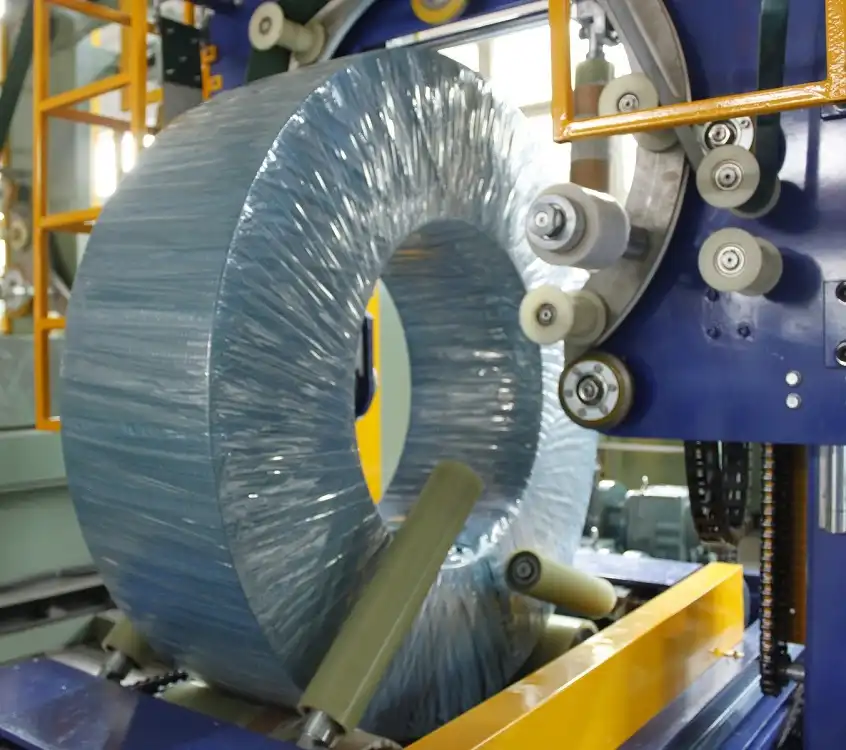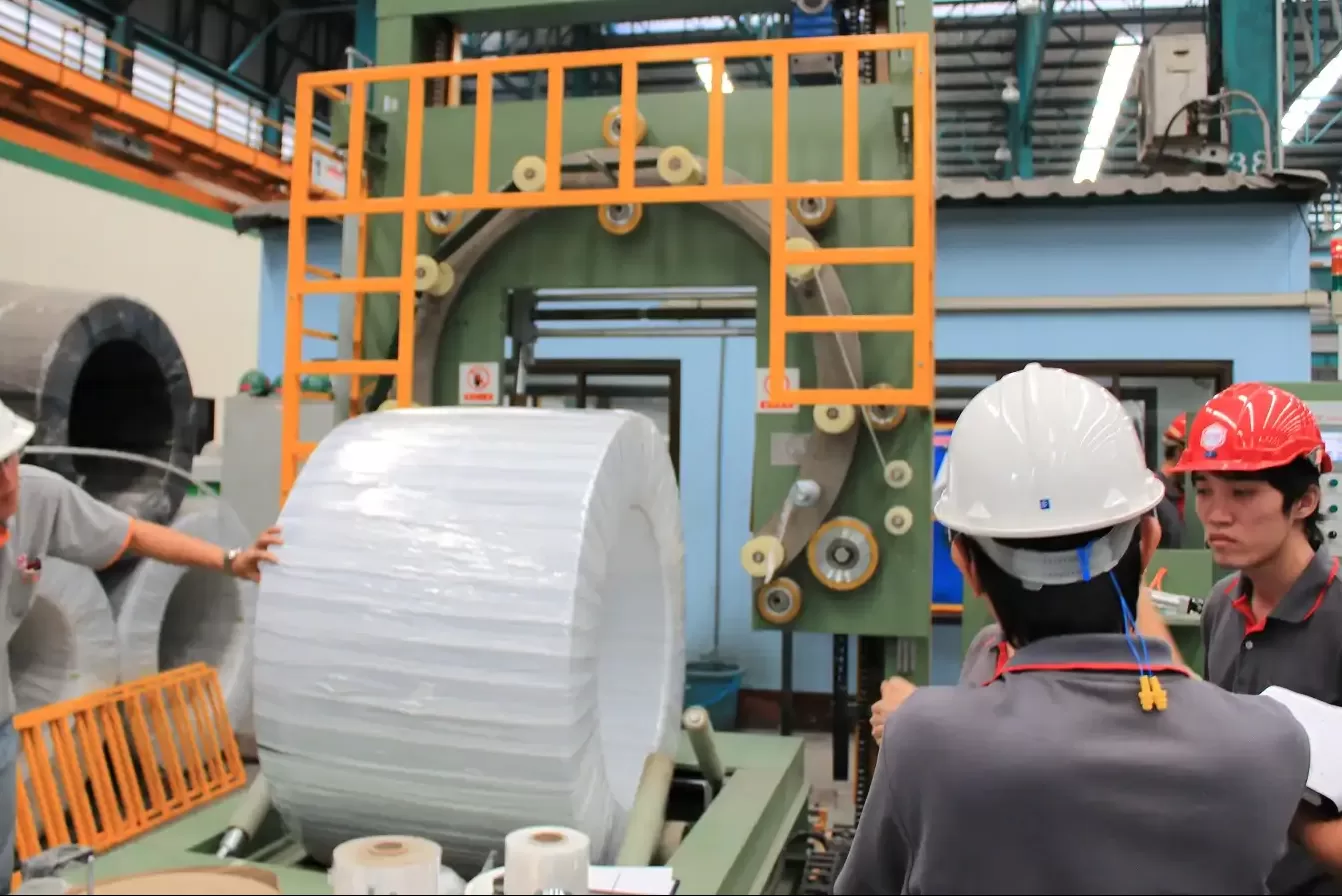Steel coil packing faces increasing scrutiny as environmental consciousness grows. Industries are now challenged to minimize waste, reduce material usage, and adopt sustainable practices. Understanding the environmental requirements is crucial for businesses aiming for both efficiency and ecological responsibility in their steel coil packaging processes.

Environmental requirements for steel coil packing include using recyclable and biodegradable materials like polyethylene and polypropylene, optimizing material usage through methods like ring-type wrapping to reduce waste, ensuring proper tension control to minimize damage and material overuse, and adhering to transportation safety regulations to prevent environmental hazards during transit. Embracing these practices not only aids environmental preservation but also enhances operational efficiency and brand reputation.
Transitioning towards environmentally sound steel coil packing is not just an ethical choice but a strategic imperative in today’s market. Let’s delve deeper into the specific requirements and best practices that can guide your operations towards sustainability.
Material Selection for Eco-Friendly Coil Wrapping
Selecting the right materials is the cornerstone of environmentally responsible steel coil packing. The choice directly impacts recyclability, waste reduction, and overall environmental footprint. Moving away from traditional, less sustainable options is key to meeting modern environmental expectations.
For eco-friendly steel coil wrapping, polyethylene (PE) and polypropylene (PP) are preferred for ring-type wrapping due to their recyclability and lower environmental impact compared to laminated or VCI paper. Choosing between PE and PP depends on specific needs: PE offers superior flexibility and tear resistance, while PP provides enhanced rigidity. Considering material properties, recyclability infrastructure, and cost-efficiency ensures optimal environmental performance.

Delving Deeper into Sustainable Material Attributes
Choosing sustainable materials for coil wrapping involves a nuanced understanding of material properties and lifecycle impacts. It’s not just about recyclability at end-of-life, but also about resource efficiency during production and minimizing environmental harm throughout the material’s journey. A critical approach involves assessing various material attributes against environmental benchmarks.
Polyethylene vs. Polypropylene: A Detailed Comparison
While both PE and PP are considered better choices than traditional laminated materials, their subtle differences are environmentally relevant.
| Material | Strength | Flexibility | Moisture Resistance | Recyclability | Environmental Impact of Production |
|---|---|---|---|---|---|
| Polyethylene (PE) | High | High | Excellent | High | Moderate |
| Polypropylene (PP) | High | Medium | Good | High | Lower |
| VCI Paper | Low-Medium | Medium | Poor | Low | High (Chemical Processing) |
| Laminated Paper | Medium | Low | Fair | Very Low | High (Multi-material, difficult to recycle) |
As the table indicates, while both PE and PP are strong and recyclable, PP generally has a lower environmental impact during production. However, the choice should also consider the specific application requirements. For coils needing superior moisture protection, PE might be favored. For applications prioritizing material rigidity and potentially lower production impact, PP could be the better choice.
The Role of Recycled Content and Circularity
Beyond material type, the incorporation of recycled content is crucial. Utilizing recycled PE or PP reduces the demand for virgin plastics, decreasing reliance on fossil fuels and lowering greenhouse gas emissions associated with plastic production. Furthermore, designing packaging for circularity – ensuring it can be easily recycled and reintroduced into the material stream – is paramount. This involves considering the entire lifecycle, from sourcing to end-of-life management, to truly minimize environmental impact. The future of sustainable coil packing lies in maximizing recycled content and optimizing for a closed-loop system.
Ensuring Proper Tension Control for Minimal Material Waste
Effective tension control during coil wrapping is not just about package integrity; it’s also a key environmental factor. Improper tension leads to material wastage, either through over-wrapping or package failure requiring re-wrapping. Optimizing tension is thus an environmental efficiency imperative.
Proper tension control in coil wrapping minimizes material waste and energy consumption. Techniques include regular machine calibration, using consistent quality materials, and implementing real-time tension adjustment systems. These methods prevent over-wrapping, reduce material breakage, and ensure optimal use of wrapping films, directly contributing to environmental sustainability by reducing material throughput and waste generation.
Advanced Techniques for Tension Management and Resource Efficiency
Achieving optimal tension control goes beyond basic adjustments; it requires integrating advanced technologies and methodologies to ensure both package security and environmental responsibility. Exploring these techniques reveals how precision in wrapping directly translates to ecological benefits.
Precision through Technology: Real-Time Adjustment Systems
Modern coil wrapping machines equipped with real-time tension adjustment systems are at the forefront of minimizing material waste. These systems utilize sensors to continuously monitor film tension and automatically adjust wrapping parameters on-the-fly.
| Technique | Description | Environmental Benefit | Operational Advantage |
|---|---|---|---|
| Real-Time Adjustment | Sensors and feedback loops modulate tension dynamically | Prevents over-wrapping, reduces film consumption | Consistent wrapping quality, less operator intervention |
| Machine Calibration | Regular inspection and calibration of machinery | Ensures accurate tension application, minimizes errors | Reduced material breakage, lower downtime |
| Material Consistency | Using uniform quality films | Predictable tension behavior, less need for adjustment | Stable wrapping process, improved efficiency |
Real-time systems adapt to variations in coil size and material properties, ensuring consistent tension without excessive film usage. This precision reduces material consumption significantly compared to manual or less sophisticated systems. For example, a 15% reduction in downtime due to real-time adjustments, as mentioned in the source material, directly correlates to less material being wasted on re-wrapping damaged or improperly secured coils.
Training and Best Practices: Human Element in Waste Reduction
While technology plays a vital role, operator training and adherence to best practices are equally important. Well-trained operators can identify potential issues early, ensure correct machine setup, and minimize material waste through careful monitoring and adjustments. Implementing standard operating procedures (SOPs) for tension control and material handling further contributes to consistent and environmentally conscious wrapping processes. Combining advanced technology with skilled operation provides a holistic approach to minimizing waste and maximizing resource efficiency in coil packing.
Transportation Safety Measures and Environmental Protection
Transportation of steel coils presents both safety and environmental challenges. Insecurely packed coils can lead to accidents and material damage, with potential environmental repercussions from spills or contamination. Robust transportation safety measures are therefore intrinsically linked to environmental protection.
Transportation safety measures for steel coil packing are crucial for preventing accidents and minimizing environmental risks. Key measures include utilizing robust coil handling equipment, employing secure load securing techniques with straps and pads, and ensuring comprehensive staff training on safety protocols. These measures prevent load shifting, spillage, and potential environmental contamination during transit, aligning safety and environmental responsibility.
Integrating Environmental Considerations into Transportation Protocols
Transportation safety isn’t solely about preventing immediate accidents; it also encompasses long-term environmental stewardship. Choosing environmentally sound transportation methods and materials further enhances the sustainability of the entire coil packing process. Let’s examine how to broaden transportation safety to include ecological responsibility.
Sustainable Transportation Modes and Route Optimization
The mode of transportation itself has a significant environmental impact. Prioritizing rail or sea transport over road freight, when feasible, reduces carbon emissions per ton-mile. Furthermore, optimizing transport routes to minimize distance and fuel consumption directly lowers the environmental footprint.
| Safety Measure | Description | Environmental Impact Reduction | Co-benefit |
|---|---|---|---|
| Equipment Utilization | Robust coil handling machinery | Reduced risk of accidents and spills, preventing contamination | Enhanced operational efficiency, faster loading/unloading |
| Load Securing Techniques | Straps, pads, locks for secure cargo | Prevents load shifting/spillage, protects environment | Minimized product damage, lower loss rates |
| Staff Training | Safety protocols and emergency procedures | Preparedness for spills, faster response, less environmental harm | Reduced accidents, improved workplace safety |
| Route Optimization | Efficient routing, shorter distances | Lower fuel consumption, reduced emissions | Reduced transportation costs, faster delivery times |
Integrating environmental considerations into transportation planning goes beyond regulatory compliance; it demonstrates a commitment to holistic sustainability. For instance, a 20% increase in delivery precision, as mentioned in the source material due to integrated safety strategies, not only improves workflow but also minimizes potential environmental risks associated with delays and mishandling.
Eco-Friendly Securing Materials and Waste Management
The materials used for load securing also matter environmentally. Choosing reusable or recyclable straps and padding materials reduces waste compared to single-use options. Implementing proper waste management protocols at loading and unloading points prevents environmental contamination from discarded packaging and securing materials. A comprehensive approach to transportation safety integrates ecological mindfulness at every stage, from equipment selection to material disposal.
Coil Packing Machine Certifications and Regulatory Compliance
Navigating the landscape of coil packing machine certifications is essential for ensuring compliance with both safety and environmental regulations. These certifications serve as benchmarks, validating that machinery meets established standards and promotes responsible operation. Understanding these certifications is key to demonstrating
Coil packing machines require certifications to ensure safety, quality, and environmental compliance. Key safety certifications include CE Marking, ISO 9001, and UL Certification, ensuring operational safety and quality management. Environmental certifications like ISO 14001, ENERGY STAR, and RoHS compliance validate eco-friendly operation, energy efficiency, and restricted use of hazardous substances. These certifications are vital for legal operation, market access, and demonstrating a commitment to responsible manufacturing and environmental protection.
Deciphering Essential Certifications for Sustainable Operations
The array of certifications can seem complex, but each plays a crucial role in validating different aspects of machine performance and environmental impact. Breaking down these certifications into categories helps clarify their importance and guides businesses in ensuring comprehensive compliance.
Safety, Quality, and Environmental Certification Landscape
Certifications can be broadly categorized into safety, quality management, and environmental performance. Each category addresses distinct but interconnected aspects of responsible machine operation.
| Certification Category | Certification Example | Focus | Environmental Relevance | Business Benefit |
|---|---|---|---|---|
| Safety | CE Marking | Health, Safety, Environmental Protection (EEA) | Ensures machine meets EU environmental directives | Legal market access in EEA, reduced risk of accidents |
| UL Certification | Electrical Safety (North America) | Minimizes electrical hazards, indirectly reducing environmental risks | Assurance of safety, enhanced reputation, market access | |
| Quality | ISO 9001 | Quality Management Systems | Consistent product quality, efficient processes | Improved operational efficiency, customer trust, quality assurance |
| Environmental | ISO 14001 | Environmental Management Systems | Comprehensive environmental management, resource efficiency | Enhanced environmental performance, regulatory compliance, image |
| ENERGY STAR | Energy Efficiency | Reduced energy consumption, lower carbon footprint | Lower operating costs, energy savings, sustainability image | |
| RoHS Compliance | Restriction of Hazardous Substances | Minimizes hazardous materials in machine components | Safer manufacturing, compliance with environmental directives |
Understanding this certification landscape enables businesses to strategically pursue certifications relevant to their market, operational priorities, and environmental goals. Investing in certified machinery not only ensures regulatory compliance but also positions companies as responsible and forward-thinking in an increasingly environmentally conscious world.
Conclusion
Environmental requirements for steel coil packing are multifaceted, encompassing material selection, operational practices, transportation protocols, and regulatory adherence. Embracing eco-friendly materials like recyclable polymers, optimizing tension control to minimize waste, implementing safe and environmentally conscious transportation, and ensuring machine certifications are all vital components of a sustainable approach. By integrating these considerations, businesses can not only meet growing environmental expectations but also enhance operational efficiency, reduce costs, and build a stronger, more responsible brand image in the global marketplace.

